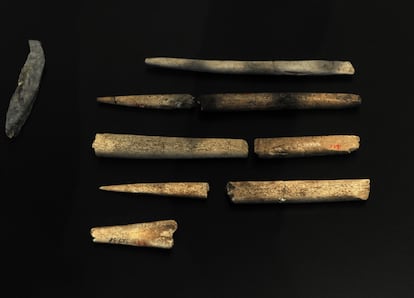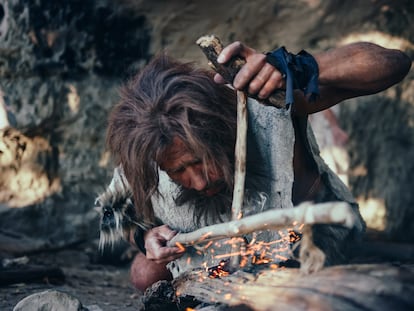A technological explosion 600,000 years ago sheds light on the ability that made us human
Researchers propose that cumulative culture may predate the separation of the Neanderthal and ‘Homo Sapiens’ lineages, and that a common ancestor could have developed it

If you look around you, you are surrounded by technology and chances are high you don’t know how it works. And if you do, you wouldn’t be able to reproduce it. And we’re not just talking about the complex chips of the cell phone. The ink that impregnates the pages of a book, the synthetic fabric of a T-shirt or even a simple a metal key requires an enormous and combined amount of knowledge, which is distributed among many people and which emerged from the accumulation of knowledge over countless generations. This ability to acquire knowledge from our ancestors and pass it on to our descendants after adding improvements — and to do so with precision, beyond the wholesale copying that other species do, such as has been observed in chimpanzees and monkeys — is one of the things that still seem exclusive to humanity.
Therefore, to look for the origins of this ability to accumulate culture is also to look for something similar to our human origin. An article published on Monday in the journal PNAS and authored by Jonathan Paige, from the University of Missouri, and Charles Perreault, from Arizona State University, tries to identify that crucial moment, which the researchers place around 600,000 years ago. They arrived at this figure after analyzing stone tools from the last 3.3 million years, comparing the complexity of tools produced by other animals and doing experiments in which researchers made their own tools to put themselves in the shoes of those prehistoric humans.
There are indications that more than three million years ago, in places like Dikika, in Ethiopia, or Lomekwi, in Kenya, the first hominids used stone artifacts to extract meat from animals. These early tools made possible a better diet that allowed for growth of the body and brain and greater manual skill to create better gadgets. At first, cores and flakes were generated without much planning, pursuing an intuitive utility like that sought by some monkeys today when producing flakes, not unlike those used by the first members of the genus Homo. This way of doing things was transmitted for hundreds of thousands of years, at a rate that was still far from that associated with the human species.
The change was gradual, with technologies that could be learned with some ease and little information, simply by watching how others did it. The authors even propose that 1.8 million years ago, after the emergence of hand axes, which represented an important technological leap and greater planning, a certain stagnation occurred, because manual skill was not enough to continue with the same rapid advance. That changed 600,000 years ago. The transformations that began to be seen in the tools of that time, finer and more diverse, required dedicating a lot of time to learning, and it is possible that stone carving was transmitted in the same way that a trade is taught now.
The authors argue that the rapid and continuous increase in complexity can be explained by the ability of those hominids to accumulate culture. A greater variety of tools, carving styles and combinations of elements appeared that exponentially multiplied the possibilities of technology. As new carving techniques were discovered, design possibilities expanded. For example, soft hammer percussion and pressure carving allow thinner hand axes to be made than is possible with hard hammer percussion. These more complex technologies were also more difficult to discover, master, and teach.
The evolution of cultural heritage occurs at the same time as the biological changes that facilitate learning from a very early stage of life. Cooking, for example, reduced the size of the intestine and made it easier to extract more energy to fuel the brain from the same amount of food. This favored the growth of a brain with the capacity to acquire increasingly complex skills or to handle the fingers with a finesse essential to create more subtle devices.
Although the great technological explosion is usually associated with the appearance of modern humans, Paige and Perreault propose that cumulative culture may predate the separation of the Neanderthal and H. Sapiens lineages, and that a common ancestor could have developed it. “This is reflected in the overlapping complexity of both groups during the Late Pleistocene,” they say, and could explain why some researchers have seen that the technologies associated with Neanderthals in the Middle Pleistocene are more complex than some related to modern humans at the time.
Ignacio de la Torre, a researcher at Spain’s National Research Council (CSIC), doubts that there is convincing evidence that Neanderthals were capable of developing more advanced tools than Sapiens, but suggests that “the technological or innovation explosion could be attributed to precursors of Homo sapiens.” Although the relationship between archaeological remains and the biological characteristics of the beings who created them is not always clear, and many technologies are so useful that they are transmitted between species for long periods of time, De la Torre does not rule out the possibility that the innovative fever was attributable to a human species with more modern characteristics and that has not yet been identified.
“Every four or five years, new discoveries of older Homo sapiens are announced,” he says. “Until about 15 years ago, the oldest remains were 100,000 years old. Later, remains from 150,000 years ago appeared, 50% older, and in 2017 remains of modern humans from 300,000 years ago were reported. The chronology of Homo sapiens has doubled in just over 15 years,” says De la Torre. “These equivalences between biology and archeology must be taken with a pinch of salt, but who knows whether within a few years, remains of Homo sapiens from half a million years ago will be found?”
Sign up for our weekly newsletter to get more English-language news coverage from EL PAÍS USA Edition
Tu suscripción se está usando en otro dispositivo
¿Quieres añadir otro usuario a tu suscripción?
Si continúas leyendo en este dispositivo, no se podrá leer en el otro.
FlechaTu suscripción se está usando en otro dispositivo y solo puedes acceder a EL PAÍS desde un dispositivo a la vez.
Si quieres compartir tu cuenta, cambia tu suscripción a la modalidad Premium, así podrás añadir otro usuario. Cada uno accederá con su propia cuenta de email, lo que os permitirá personalizar vuestra experiencia en EL PAÍS.
¿Tienes una suscripción de empresa? Accede aquí para contratar más cuentas.
En el caso de no saber quién está usando tu cuenta, te recomendamos cambiar tu contraseña aquí.
Si decides continuar compartiendo tu cuenta, este mensaje se mostrará en tu dispositivo y en el de la otra persona que está usando tu cuenta de forma indefinida, afectando a tu experiencia de lectura. Puedes consultar aquí los términos y condiciones de la suscripción digital.
More information
Archived In
Últimas noticias
From Andorra to Gibraltar, a black market for Ozempic exploits its success: ‘They’re the most sought-after products in the world’
A floating school teaches children how to save Lake Atitlán
Pablo Escobar’s hippos: A serious environmental problem, 40 years on
From safe-haven investment to geostrategic weapon: Who owns the most gold and where are the bars kept?
Most viewed
- Why we lost the habit of sleeping in two segments and how that changed our sense of time
- Charles Dubouloz, mountaineering star, retires at 36 with a farewell tour inspired by Walter Bonatti
- Venezuela faces its most tense Christmas yet
- CBS in crisis after pulling a report on Trump’s deportations to El Salvador (which later leaked online)
- Bukele clan fumes over investigation exposing their new wealth











































